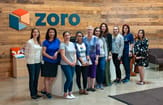It's a recent Sunday afternoon and I'm en route to my first Meal Share in Roscoe Village. A person named Aaron is having "Gnocchi Making" night with special host, his Italian grandmother.
I walk up his steps, bottle of wine in hand. The door swings open and my eyes scan a room - at least half the length of a football field - with art-lined, wooden walls. Light cuts through the windows, pronouncing tables full of cheese and wine. In front of me is Aaron's grandma, chanting gnocchi rolling instructions in broken English.
[ibimage==31686==Medium==none==self==ibimage_align-right]
My first Meal Sharing event transpired with hundreds of carbs and conversations. It was such a unique experience - very cultural, I would say. Above all though, the conversations were the highlight of my night.
Initially, the platform targeted international travelers looking for authentic "local" experiences. It was a success from the start, with Meal Shares happening on boats on the Thames River in England and apartments in Wicker Park. Now, Meal Sharing is seeing business take off on a local level with people looking for new dining experiences within their own communities.
It all began, however, with one Meal Share in Southeast Asia, when founder Jay Savsani was traveling with his cousin and friend in Cambodia.
Like many travelers today, the trio’s path was lit by way of TripAdvisor and Lonely Planet. Savsani found that each site's itineraries just featured “over-priced Navy Pier versions of Siem Reap, Cambodia.” After about two days, Savsani said he realized these attractions weren’t cutting it.
Savsani wanted a real Cambodian experience. So he went to the front desk of his hotel and asked the concierge if and where he could get a home-cooked meal that night. One hour later, he found himself in the Cambodian countryside with his friend, cousin and the concierge, eating food that he couldn’t pronounce (or for this article’s purposes, spell).
[ibimage==31688==Original==none==self==ibimage_align-right]
One suggestion, made two years ago, catalyzed a multinational company solving the very problem Savsani had. Let’s hope he tipped that concierge well.
"When I came back to Chicago, I wanted out of my company [a digital marketing firm] and started Meal Sharing and went full force because there needed to be a platform for people to connect in a meaningful way over home-cooked food,” Savsani said.
First, Savsani built the Meal Sharing website. Second, he went on a road trip with lead developer Adam Mark and designer John Franchi to test the market and meet their consumers. “For me to feel passionate about something, I needed to know the idea had legs and cultural significance and could be something huge,” Savsani said.
So the team Meal Share-hopped around the Northeast, hitting DC and NYC and ultimately came to the verdict that "yes,” Meal Sharing was on.
People began to Meal Share right away. In fact, within one year Meal Sharing was in 425 cities. The concept and numbers earned Meal Sharing a spot in The Impact Engine, a 12-week accelerator program run by OpenTable founder Chuck Templeton.
This past September Meal Sharing entered the accelerator, which is still running. Over the 12 weeks, one of the team’s main goals has been to drive the frequency of Chicago Meal Shares to one each night of the week. Another has been to create a payment structure that will benefit both the business and its users, which the team has been calling “free to fee.”
When asked what it was like to go from “free to fee,” Savsani said: “Our idea was never 'pay or no pay' - it was making the concept work.”
On their market research road trip, the team made sure to talk to their users about payment: “We met with our power hosts and our power guests and we asked them, 'Would you still use our platform [if there was a fee]?' and the sentiment we got was, 'Yes - why didn't you guys do this in the first place?’”
The team actually found that in creating a payment option the platform became more accessible. Savsani said when the platform was “totally free we were kind of alienating our guests who could not reciprocate for whatever reason.” These reasons often included not having a place of their own to host or living in a tiny apartment, unsuitable for large parties.
"That for me was heartbreaking because it was like, they can't participate in this beautiful platform where they can connect with people because they feel guilty to go to a meal where they can't chip in,” Savsani said.
[ibimage==31685==Medium==none==self==ibimage_align-left]
So the team implemented a “chip-in” fee and saw more Meal Shares happen in one month than in one year. On average in Chicago, the chip-in ranges from $8 to $12. This covers the cost of time and ingredients and often leaves the host with some extra dough at the end of the night (that pun had to happen).
This January, Meal Sharing will pitch their business in front of investors and the community at The Impact Engine’s Demo Day. With Meal Shares happening now nightly in Chicago and a chip-in fee in place,the team has focused on developing its app and streamlining its Meal Share set-up processes online.
Ultimately, Savsani says Meal Sharing’s goal is “to create this platform so that you can point anywhere on a map and be welcome to a home-cooked meal.” And with successes from Cambodia to Chicago already, they’ve proven they can take this goal far.





